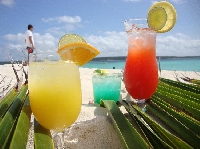
Where does rum come from and why is it tops for mixed alcoholic beverages
Yell out “Yo ho ho!” in any crowd and you’re guaranteed to get at least one response of “and a bottle of rum!” Most of us know the source of this iconic sea shanty is Robert Lewis Stevenson’s classic “Treasure Island,” but where does this spirit originate and why would pirates stand on a dead man’s chest for it?
The history of fermented drinks goes back to the first prehistoric human who observed animals staggering around after eating rotting fruits and decided it looked like fun so he tried them himself. As you might expect, he liked the feeling and it probably wasn’t long before he couldn’t wait for rotten fruits and attempted to make his own “mojito“ drinks out of any fruits or plants he had available.
Since sugar is critical in the fermentation process, sugar cane was a popular choice and drinks from sugar cane juice were first made in Indonesia in the East Indies. Traders brought sugar cane to China, India, the Middle East and Africa. Spanish and Portuguese explorers took sugar cane from Africa to the Canary and Azore Islands and then to the Americas, where the climates of Cuba, Haiti, the Dominican Republic and Brazil proved to be fertile ground for the plant.
~
With the rest of the world having an insatiable sweet tooth, the sugar industry flourished in the Caribbean as plantations grew sugar cane and mills crushed the plants and extracted and boiled the juice to make crystallized sugar. The liquid left over was molasses, which was thrown away until someone noticed that when it was mixed with water and left out in the sun, it would ferment. That liquid was then distilled and the spirit was the first form of what we now call rum, basically answering the question of where does rum come from.
There are many theories on the origin of the name “rum.” One is that it comes from the end of the Latin word for sugar – saccharum. Another is that it’s derived from “rumbullion,” a slang word meaning “tumult.” This may be tied to the ruckus raised by sailors drunk on the drink.
While rum was sometimes used as a medication or as a flavoring for baked goods, it was more often sold at reduced prices to naval ships in the Caribbean in return for keeping pirates away. The British navy gave sailors a daily ration of rum or a water-rum mix called “grog” until the 1960s.
Historians attribute the popularity of rum as one of the causes of the “slavery triangle” where molasses were shipped to New England for distilling, rum was shipped to Africa to trade for slaves and slaves were brought to the Caribbean islands to work on the plantations. The American Civil War ended slavery and the popularity of rum as it was replaced by spirits made from grains.
Today, rum is making a strong comeback as a result of tourism, small distilleries making unique variations and the rising appreciation of aged rums, new rum cocktails and rum-based products. Rum and rum extract continues to be a popular flavoring ingredient in cookies, cakes and candies.
With sugar cane being replaced by sugar beets which can be grown outside of tropical climates, there are now excellent rums from Australia, the United States and the Philippines. No matter where it’s from, open a bottle of rum or brew a pot of rum-flavored coffee and you’ll quickly have fifteen men yo-ho-ho-ing for a drink.
